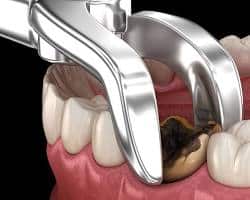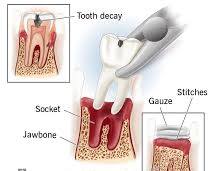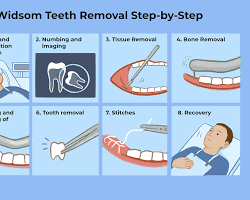Simple Extraction:

Surgical Extraction:
Wisdom Teeth Extraction:
Other Types of Tooth Extractions:
- Root removal: This is a type of surgical extraction that is used to remove the root of a tooth that has broken off below the gum line.
- Pre-prosthetic extraction: This is a type of extraction that is performed to make room for dentures or other dental prosthetics.
Factors Affecting Which Type of Extraction is Needed:
The type of extraction that is needed will depend on a number of factors, including:
- The position of the tooth
- The condition of the tooth
- The amount of bone surrounding the tooth
- The patient’s overall health
While simple extractions are generally straightforward procedures, several factors can influence the experience and outcome:
Tooth-related factors:
- Root anatomy: Teeth with complex root structures (multiple roots, curved roots) can be more challenging to remove, increasing the risk of complications like bone fracture.
- Tooth condition: Fragile teeth due to decay or previous restorations may require additional care during extraction to avoid breakage.
- Impaction: Even visible teeth might be slightly impacted, requiring minor adjustments during removal.
- Infection: The presence of infection can complicate the extraction process and necessitate additional treatment.
Patient-related factors:
- Overall health: Underlying medical conditions like diabetes or heart problems may require specific precautions during the procedure.
- Bone density: Low bone density can increase the risk of socket damage during extraction.
- Anxiety and pain tolerance: Individual anxiety levels and pain tolerance can influence the experience and potentially require additional sedation options.
Pain Levels in Surgical Tooth Extractions:
Pain Intensity:
- Studies reveal diverse experiences: Research like “Pain levels after third molar surgical removal: An evaluation of predictive variables reports moderate to severe pain for some patients undergoing surgical third molar extraction. However, another study in the National Center for Biotechnology Information (NCBI) titled “Do Patients Have the Same Experience of Pain Following Tooth Extraction and Dental Implants? suggests mean pain severity at 6.42 on a 10-point scale, decreasing significantly within 48 hours post-surgery.
Factors Affecting Pain:
- Complexity of surgery: longer and more challenging procedures involving bone removal or tooth sectioning often correlate with higher pain levels.
- Impacted teeth: Impacted wisdom teeth, particularly those positioned horizontally or deeply embedded, can lead to increased discomfort due to extensive tissue manipulation.
- Individual pain tolerance: Pain perception is subjective, and individual thresholds vary significantly.
- Anesthesia type: general anesthesia offers complete pain control during the procedure, whereas local anesthesia may not fully eliminate discomfort for some individuals.
- Post-operative care: Following instructions for pain medication, swelling reduction, and oral hygiene contributes significantly to managing discomfort.
Pain Levels in Wisdom Teeth Extraction:
Individual pain perception varies greatly, influenced by factors like pain tolerance, anxiety, and past experiences. This overview provides general insights, but seeking personalized advice from your dentist is crucial.
Pain Intensity:
- Studies offer valuable perspectives:
- Moderate to severe pain initially, decreasing by day 3.
- 60% experienced moderate pain, and 20% experienced severe pain.
- An average pain score of 4.9 on a 10-point scale.
Factors Affecting Pain:
- Complexity: More complex procedures involving bone removal or multiple extractions often lead to higher pain levels.
- Location: Lower jaw extractions can be more painful due to denser bone and sensitive nerves.
- Impaction: The degree of impaction influences the difficulty of removal and, potentially, pain intensity.
- Post-operative complications: dry socket, infection, or swelling can exacerbate pain.
Mitigating Pain and Discomfort After Tooth Extraction:
1. Medication:
- Prescribed Pain Medication: Follow your dentist’s instructions for pain medication dosage and schedule. Commonly used medications include ibuprofen, naproxen, and sometimes stronger options for more complex procedures.
- Over-the-Counter Pain Relievers: Consider using over-the-counter medications like acetaminophen for mild pain after consulting your dentist about potential interactions with prescribed medications.
2. Ice Therapy:
- Apply ice packs wrapped in a thin cloth to the extraction site for 15-20 minutes at a time, several times per day. This helps reduce swelling and pain. Avoid direct contact with the skin to prevent tissue damage.
3. Elevation:
- Elevate your head with pillows while resting or sleeping to reduce swelling and promote drainage.
4. Saltwater Rinses:
- Start gentle saltwater rinses (warm water mixed with half a teaspoon of salt) 24 hours after extraction. This helps cleanse the area, promote healing, and reduce the risk of infection. Don’t rinse too hard to keep the blood clots from moving.
5. Dietary Modifications:
- Stick to soft, lukewarm foods that require minimal chewing for the first few days. This minimizes discomfort and promotes healing. Avoid hot, spicy, or hard foods that can irritate the wound.
6. Gentle Oral Hygiene:
- Maintain good oral hygiene by brushing and flossing gently around the extraction site, taking care not to disturb the blood clot. Use a soft-bristled toothbrush and fluoride toothpaste.
7. Rest and Relaxation:
- Allow your body ample rest to heal and recover. This also helps manage stress and anxiety, which can contribute to pain perception.
Additional Tips:
- Avoid smoking and tobacco products: These can hinder healing and increase the risk of infection.
- Limit alcohol consumption: Alcohol can interact with medications and affect healing.
- Manage swelling: Cold compresses and elevation can help reduce swelling, which can contribute to pain.
- Control bleeding: If excessive bleeding occurs, apply gentle pressure with gauze and contact your dentist immediately.
- Address dry socket: If you experience severe pain, a throbbing sensation, and a foul odor coming from the extraction site, contact your dentist promptly, as this might indicate dry socket, a painful post-operative complication.
Patient Testimonials and Case Studies
Here are some testimonials from satisfied patients who underwent tooth extractions at FLOSS Dental:
- “I was nervous about getting my wisdom teeth removed, but the team at FLOSS Dental Sugar Land made the experience smooth and virtually pain-free. I couldn’t be happier with the results!”
- “After years of dealing with tooth pain, I finally decided to have a problematic tooth extracted at FLOSS Dental Sugar Land. The procedure was quick, and the recovery was easier than I expected. Highly recommend!”
Alternatives to Tooth Extraction
While extraction may be necessary in some cases, FLOSS Dental Sugar Land explores alternative treatments whenever possible, such as root canals or crowns, to preserve natural teeth and maintain oral health. However, extraction may be the best option in situations where the tooth is severely damaged or compromised.
FAQs
Q: Is Tooth Extraction Painful?
A: While tooth extraction may cause some discomfort, FLOSS Dental utilizes advanced anesthesia techniques and effective pain management strategies to minimize pain during and after the procedure. Patients are encouraged to communicate any discomfort to their dental team, who will adjust their treatment accordingly.
Q: How Long Does Tooth Extraction Take?
A: The duration of a tooth extraction varies depending on factors such as the type and complexity of the procedure. Simple extractions may take only a few minutes, while surgical extractions, especially for impacted teeth, can take longer. On average, most extractions are completed within 20 to 40 minutes.
Q: What Are the Risks of Tooth Extraction?
A: While tooth extraction is generally safe, there are some potential risks and complications, including infection, excessive bleeding, and nerve damage. However, FLOSS Dental minimizes these risks through thorough assessment, proper technique, and adherence to strict safety protocols.
Q: How Much Does Tooth Extraction Cost?
A: The type of tooth extraction, the difficulty of the procedure, and whether or not the patient has dental insurance coverage all affect how much a tooth extraction will cost. We offer transparent pricing and may also provide financing options to make treatment more affordable for patients.
Q: What Happens After Tooth Extraction?
A: After a tooth extraction, patients can expect some degree of swelling, discomfort, and minor bleeding, which typically subside within a few days. Following FLOSS Dental’s aftercare instructions, including pain management, swelling reduction techniques, dietary recommendations, and proper oral hygiene, is essential for a speedy and successful recovery.
For more information or to schedule a consultation with FLOSS Dental Sugar Land, contact them at (281) 864-3470. Don’t let tooth pain or discomfort affect your quality of life; trust the experts at FLOSS Dental Sugar Land for compassionate and expert care.


